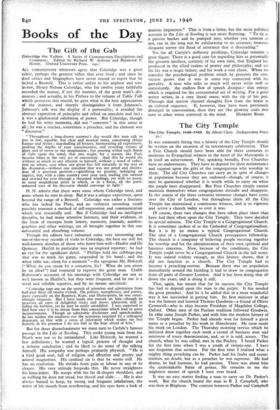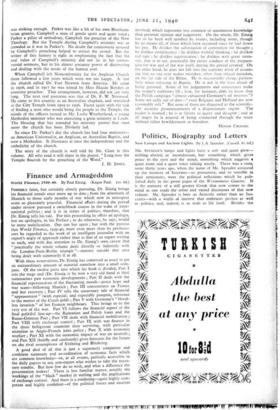The City Temple IT was eminently fitting that a history
of the City Temple should be written on the occasion of its tercentenary celebration. That a Free Church should have been able for three centuries to maintain its Evangelical witness in the heart of the Metropolis is in itself an achievement. For, speaking broadly, Free Churches have no endowments. They have to depend for their maintenance and support upon the gifts of the congregations who worship in them. The old City Churches can carry on in spite of changes in population because they are endowed—though, of course, it may be questioned whether it is worth while to carry on when the people have disappeared. But Free Churches simply cannot maintain themselves when congregations dwindle and disappear. In the course of the three centuries immense changes have come over the City of London, but throughout them all the City Temple has maintained a continuous witness, and is as vigorous and active a church today as ever it was.
Of course, these vast changes that have taken place since 164o have had their effect upon the City Temple. They have decided its special mission. The City Temple is a Congregational Church. It is sometimes spoken of as the Cathedral of Congregationalism. But it is by no means a typical Congregational Church. The idea of a Congregational Church presupposes fellowship. The church is a company of believing people meeting together for worship and for the administration of their own, spiritual and business concerns. Now, because of the conditions, the City Temple could never be a Congregational Church in the full sense. It was indeed evident enough, as this history shows, that it did not function as a church. The City Temple had to become a preaching-station. Because there was no population immediately around the building it had to draw its congregation from all parts of Greater London. And it has been doing that all down the years, and is doing it still.
That, again, has meant that for its success the City Temple has had to depend upon the man in the pulpit. It has needed the great preacher. And let it be added that in a most wonderful way it has succeeded in getting him. Its first minister in 1640 was the famous and learned Thomas Goodwin—a friend of Oliver Cromwell—who in 1650 became President of Magdalen College, Oxford. Other men of the Puritan tradition followed Goodwin. In 1869 came Joseph Parker, and with him the modern history of the Temple began. Parker had already won for himself a great name as a preacher by his work in Manchester. He soon made his mark on London. The Thursday morning service which he initiated drew together each week a crowd of business men and ministers of every denomination, and, so it is said, actors. The church, when he was called, met in the Poultry. I heard Parker for the first time when I was a youth of twenty-one. I have not forgotten that sermon. For the first time I realised what a mighty thing preaching can be. Parker had his faults and eccen- tricities, no doubt, but as a preacher he was suprenie. He had drama, he had humour, he had passion. There was about him the unmistakable flame of genius. He remains to me the mightiest master of speech I have ever heard.
It was no easy matter finding a man to carry on Dr. Parker's work. But the church found the Man in R. J. Campbell, who was then at Brighton. The contrast between Parker and Campbell was striking enough. Parker was like a bit of his own Northum- brian granite, Campbell a man of gentle spirit and quiet voice ; Parker a pillar of orthodoxy, Campbell the preacher of the New Theology. But the Temple during Campbell's ministry was as crowded as it was in Parker's. No doubt the controversy aroused by Campbell's preaching helped to attract the crowd. But the writer of this history is right in emphasising the fact that the real value of Campbell's ministry did not lie in his contro- versial sermons, but in his almost uncanny power of discovering and dealing with the needs of the human soul.
When Campbell left Nonconformity for the Anglican Church there followed a few years which were not too happy. AT last the church called Dr. Fort Newton from America. He came in 1916, and in 1917 he was joined by Miss Maude Royden as associate preacher. That arrangement, however, did not iast very long. The next real pastorate was that of Dr. F. W. Norwood. He came to this country as an Australian chaplain, and remained at the City Temple from 1919 to 1936. Faced again with the task of finding a man who would bring the people to the Temple, the minds of the officers turned to Mr. Leslie Weatherhead, a young Methodist minister who was exercising a great ministry at Leeds. The blessing that has attended his ministry proves that once more the church has been Divinely led.
So since Dr. Parker's day the church has had four ministers— an American Universalist, an Anglican, an Australian Baptist, and now a Methodist. It illustrates at once the independence and the catholicity of the church.
The story of the church is well told by Mr. Clare in this volume. All who read it will share in the prayer, " Long may the Temple flourish by the preaching of the Word."
J. D. JONES.































 Previous page
Previous page